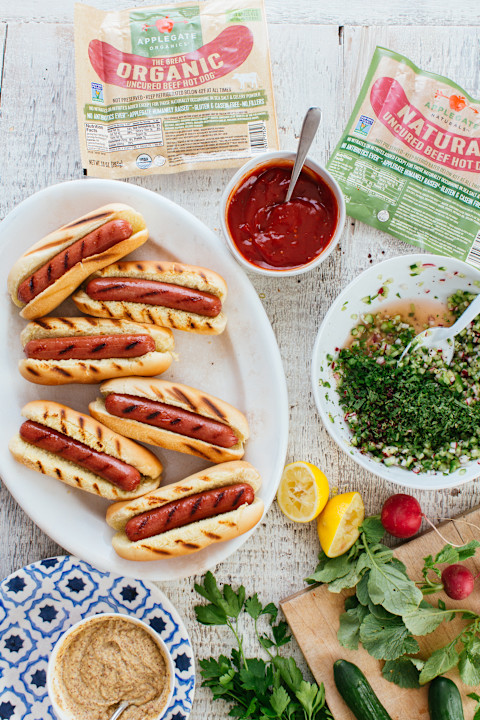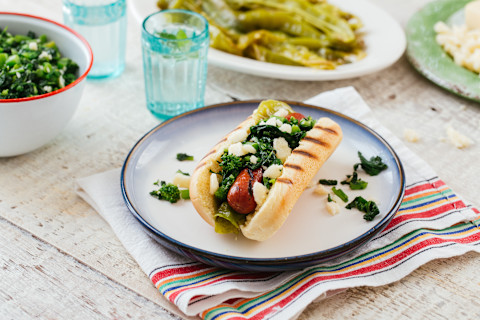
When we think of summer, lots of us think of backyard barbecues and outdoor cookouts. Summer is prime time for grilling. However, there are some pitfalls to keep on your radar so you can make more conscientious choices to support overall wellness. Taking into account the type of grill you use, the quality of the meat you choose, and how to make more balanced choices for pairings are all summer essentials.
Pick the best grill for your lifestyle.

First things first: You need to pick the grill that best suits your needs. While there are many kinds, the most common types of grills you’ll find are charcoal, gas, and electric.
Charcoal is a favorite for outdoor grilling. Its signature flavor is the draw for many—that smoky flavor is what most of us associate with barbecue. They can get hotter than gas grills, reaching up to 700 degrees Fahrenheit. Charcoal grills are also the cheapest, though they do require fresh coals for each use. A few cons, however, are the lack of temperature control and the fact that they take longer to heat up and require more cleanup because of the coal ashes. You also want to be mindful of the quality of the coals you’re using. Look for a product without additives or binders.
Gas is popular for the convenience factor. Gas grills, which reach about 400 to 600 degrees Fahrenheit, are fueled with liquid propane or natural gas, heat up quickly, and have temperature control knobs. Some gas grills allow you to create different heat zones for different preparations. They're also easier to clean than charcoal grills because they don't use coals. Propane is also portable, which makes it an attractive option if you don’t want to be confined to a particular space. However, gas grills don't impart that smoky flavor many associate with grilled foods, though some models include smoke boxes.
Electric grills require little more than access to an electrical outlet, so for people who live in buildings where gas and charcoal grills are not allowed or who prefer not to use them, this is an option. They heat up quickly, are easy to control, and require minimal cleanup. They also are available in small sizes—even tabletop.
Pick a high-quality meat.
Fuel a fun summer with better-for-you meats, fish, and poultry products. Make sure you’re choosing high-quality sausages and hot dogs made with 100 percent grass-fed beef. Applegate offers options your whole crew will love that are non-GMO and humanely raised with no antibiotics ever. When choosing chicken, go for organic poultry, and with fish, look for wild and sustainably raised options.
Regardless of what you choose, prioritize quality over quantity. Sure, it can be hard to pass up large boxes of cheap meat at your local grocery store, but the difference in taste and the peace of mind that comes from making a conscientious choice can improve your experience.
Don't forget about vegetables.

Aim to fill half your plate with nonstarchy vegetables, a quarter with protein like a grilled meat, and the last quarter with a complex carb like corn on the cob, sweet potato, or beans.
Grilled vegetables are a delicious way to add color, flavor, and nutrition to summer meals. Some great vegetables for grilling are zucchini, summer squash, peppers, onions, broccoli, cauliflower, mushrooms, and asparagus. Some starchy ones to throw on the grill are sweet potato and corn. Marinate the vegetables first with a light touch of oil, some kind of acid like citrus or vinegar, and fresh herbs. To make cooking and cleanup easier, try cutting those veggies into small pieces and skewering onto kebabs or using a grill basket.
You can also cook vegetables in foil packets, where you place the veggies in a thin layer and then fold and seal over the edges. Place the packet on the grill, cover, and let the heat steam the veggies until they're tender—usually 10 to 15 minutes.
You can also pair those burgers and dogs with a simple salad of dark leafy greens, cucumber, and tomatoes in a light dressing of olive oil and either vinegar or lemon juice. Aim to fill half your plate with your nonstarchy vegetables, a quarter with a protein, and the last quarter with a grain, starchy veggie like potato or corn, beans, or a bun.
The carcinogen conversation.
A common concern is whether grilling your food makes it more carcinogenic. When muscle meat (chicken, pork, fish, etc.) is heated to a high temperature (like in cooking over an open flame or pan-frying), potentially carcinogenic compounds heterocyclic amines (HCAs) and polycyclic aromatic hydrocarbons (PAHs) are produced. While these compounds have been linked to increased cancer risk, there are things you can do to minimize the potential effects.
For example, making the bulk of your meal vegetables is a great first step. Aside from the fact that these chemicals are not produced in high amounts when non-meat foods are cooked at high heat, adding vegetables to meals can help keep calories in a realistic range to help you maintain an appropriate weight (another lifestyle factor in cancer risk) and provide essential nutrients.
Incorporating foods with cancer-fighting properties is also a great way to potentially counteract the negative impact. For example, cruciferous vegetables like broccoli, cauliflower, and Brussels sprouts have been shown to possess powerful compounds. Leafy greens, tomatoes, sweet potatoes, and berries are all great ways to incorporate lots of cancer-fighting antioxidants. Don’t forget about the potent disease-fighting properties in herbs and spices like turmeric and rosemary. Incorporate them into marinades and spice rubs.
Flipping your meat as you cook to reduce charring and cutting off charred portions are other ways to reduce HCA and PAH exposure when you’re enjoying a grilled meal.
Clean up your condiments act.
Bottled condiments are traditionally packed with sugar, sodium, and other additives that aren’t doing you favors. Check labels. Ideally, you want something with an uncomplicated ingredients list that's free of things like coloring agents, thickeners, and preservatives.
Using more nutritious swaps like hummus or avocado in place of mayonnaise can help you increase the nutritional value of a meal while adding flavor. Using a lighter touch with classics like mayo, mustard, barbecue sauce, and the like is another way to enjoy the flavor you crave in a way that better supports your goals.
Ketchup is one of the sneakiest sources of sugar at your barbecue, but it’s actually really easy to whip up your own. To clean up your ketchup, try this super-easy low-sugar recipe.
In a small bowl, whisk together the following:
- ¾ cup low-sodium or no-salt-added tomato paste
- 2 tablespoons sweetener of choice (such as honey, maple syrup, stevia)
- 1 to 2 teaspoons blackstrap molasses
- 2 tablespoons apple cider vinegar
- ½ teaspoon sea salt
- 1 teaspoon garlic powder
- 1 teaspoon onion powder
- ¼ teaspoon fresh ground black pepper
- Pinch of cinnamon
- Pinch of cayenne pepper
- Pinch of allspice
- ½ to ¾ cup water
Once whisked together to combine, store covered in the fridge.
Lastly: Be safe.
Remember, safety is important when it comes to grilling. Make sure flammable objects are away from the grill and don’t let children play near hot surfaces. You also want to be careful to store raw meat, fish, and poultry in the fridge and cook to a safe temperature. Also, any mayo-based or dairy-containing dishes that haven’t been kept cold should be tossed after two hours or one hour if it’s over 90 degrees outside.
Also, if you’re going to consume alcohol with your meal, don’t drive.
Cheers to a clean, conscious barbecue!
